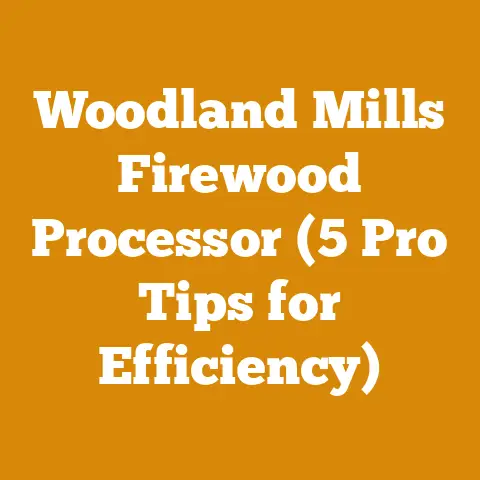How to Light a Wood Burning Fire (Tips for Tackling Downdraft Issues)
Have you ever battled a smoky fireplace, feeling like you’re losing the war against a stubborn downdraft? I know I have! Over years spent felling trees, processing wood, and heating my home with wood, I’ve learned a thing or two about coaxing a fire to life and keeping it burning strong, even when the air seems determined to push the smoke back inside. Let’s dive into the world of wood-burning fires and conquer those pesky downdrafts.
Understanding the Downdraft Dilemma
A downdraft is simply when air flows down your chimney instead of up. This forces smoke and fumes back into your living space, creating a smoky, unpleasant, and potentially dangerous situation.
What Causes Downdrafts?
Several factors can contribute to downdrafts. Identifying the cause is the first step in finding a solution. Here’s a breakdown:
- Temperature Differences: This is the most common culprit. Warm air rises. If the air inside your chimney is colder than the air outside, the natural flow is reversed, creating a downdraft.
- External Wind Pressure: Wind can blow down the chimney, especially if it’s a strong, gusty wind. The shape and location of your house can also influence how wind interacts with your chimney.
- Negative Air Pressure Inside the House: Modern, tightly sealed homes can create negative air pressure when exhaust fans (like those in your kitchen or bathroom) are running. This negative pressure can suck air down the chimney.
- Obstructions: Bird nests, leaves, or other debris can block the chimney, disrupting airflow and leading to downdrafts.
- Chimney Height and Location: A chimney that’s too short or located in a sheltered area (like under a large tree) may not have enough draw to overcome external pressure.
- Nearby Structures: Tall trees or buildings nearby can deflect wind and create downdrafts.
Why Downdrafts Are a Problem
Beyond the immediate annoyance of a smoky room, downdrafts pose several significant problems:
- Smoke Inhalation: Smoke contains carbon monoxide, a deadly, odorless gas. Even low levels of carbon monoxide exposure can cause headaches, dizziness, and nausea.
- Fire Hazard: Creosote, a flammable byproduct of burning wood, can build up in the chimney. Downdrafts can exacerbate creosote buildup, increasing the risk of a chimney fire.
- Inefficient Heating: A downdraft wastes fuel by preventing the fire from burning efficiently. You’ll end up using more wood to generate the same amount of heat.
- Soot and Odor: Downdrafts deposit soot and unpleasant odors into your home.
Diagnosing the Downdraft
Before I start suggesting fixes, I always try to figure out what’s causing the problem. Is it a one-time occurrence, or a recurring issue? Here’s how I approach diagnosing a downdraft:
- Observe the Weather: Is the downdraft happening on windy days? This points to wind pressure as the likely cause.
- Check for Obstructions: Use a mirror and flashlight to inspect the chimney flue for any blockages. If you’re not comfortable doing this yourself, hire a professional chimney sweep.
- Consider Appliance Usage: Does the downdraft occur when you’re running your kitchen or bathroom exhaust fans? This suggests negative air pressure is the culprit.
- Assess the Chimney’s Surroundings: Are there any tall trees or buildings nearby that could be deflecting wind?
- Monitor Temperature Differences: Is the downdraft more common when it’s cold outside and the chimney is cold?
Preparing for a Successful Fire: The Foundation for Preventing Downdrafts
A well-prepared fire is less likely to succumb to downdrafts. This starts long before you strike the match.
Choosing the Right Wood: Fueling Success
The type of wood you burn significantly impacts fire performance and smoke production. I’ve learned this the hard way over the years, trying to burn anything I could get my hands on!
- Seasoned Wood is Key: Seasoned wood has a moisture content of 20% or less. It burns hotter, cleaner, and produces less smoke and creosote than green wood. Green wood contains a lot of water, which must be boiled off before the wood can burn. This process cools the fire and creates more smoke. I aim for a moisture content between 15-20% for optimal burning.
- How to Season Wood: The best way to season wood is to split it, stack it loosely in a sunny, windy location, and let it dry for at least six months, preferably a year or more. I typically split my wood in the spring and let it season all summer and fall before burning it the following winter.
- Identifying Seasoned Wood: Seasoned wood will be lighter in weight than green wood. It will also have cracks in the end grain and a dull, grayish color. When you strike two pieces of seasoned wood together, they will make a hollow sound.
- Moisture Meters: A moisture meter is a valuable tool for determining the moisture content of wood. These are relatively inexpensive and can save you a lot of frustration. I use a moisture meter religiously to ensure my wood is properly seasoned.
- Hardwoods vs. Softwoods: Hardwoods (like oak, maple, and ash) are denser than softwoods (like pine and fir). Hardwoods burn longer and produce more heat, but they can be harder to ignite. Softwoods ignite easily and burn quickly, making them good for kindling.
- Hardwood BTU Content: Oak, for example, has a BTU (British Thermal Unit) content of around 27 million per cord. Maple is around 24 million, and ash is around 23 million.
- Softwood BTU Content: Pine, on the other hand, has a BTU content of around 20 million per cord.
- My Preferred Wood Mix: I like to use a mix of hardwoods and softwoods. I use softwoods to get the fire started quickly and then add hardwoods for sustained heat.
Preparing the Fireplace: A Clean Slate
A clean fireplace is a safe and efficient fireplace.
- Remove Ashes Regularly: Ashes can insulate the fire and prevent it from getting the air it needs to burn properly. I recommend removing ashes every few days, or more often if you’re burning a lot of wood. Leave a thin layer of ash to help insulate the firebox.
- Inspect the Chimney: Have your chimney inspected and cleaned annually by a qualified chimney sweep. This will remove creosote buildup and ensure that the chimney is free of obstructions.
- Check the Damper: Make sure the damper is fully open before lighting a fire. A partially closed damper can restrict airflow and cause a downdraft.
Building the Fire: The Right Technique Matters
The way you build your fire can significantly impact its performance and susceptibility to downdrafts. I’ve experimented with different methods over the years, and here’s what I’ve found works best:
- Top-Down Fire (Inverted Fire): This method is my go-to for a clean-burning, efficient fire that’s less prone to downdrafts.
- How to Build a Top-Down Fire:
- Place several large logs on the bottom of the firebox, close together.
- Layer smaller logs on top of the base logs, crisscrossing them.
- Add a layer of kindling on top of the smaller logs.
- Place a small amount of tinder (like newspaper or dry leaves) on top of the kindling.
- Light the tinder.
- Why Top-Down Fires Work: Top-down fires burn from the top down, gradually igniting the wood below. This creates a hot, clean burn that produces less smoke and creosote. The initial heat rises quickly, establishing a strong draft in the chimney.
- How to Build a Top-Down Fire:
- Traditional Teepee Fire: This method is easy to build and provides a good initial flame, but it can be more prone to smoke if not managed properly.
- How to Build a Teepee Fire:
- Place a small amount of tinder in the center of the firebox.
- Lean kindling against the tinder, forming a teepee shape.
- Light the tinder.
- Once the kindling is burning well, add small logs to the teepee, gradually increasing the size of the logs.
- How to Build a Teepee Fire:
- Log Cabin Fire: This method provides a stable, long-lasting fire, but it can be slow to get started.
- How to Build a Log Cabin Fire:
- Place two logs parallel to each other on the bottom of the firebox.
- Place two more logs on top of the first two, perpendicular to them, forming a square.
- Continue layering logs in this manner, gradually increasing the size of the square.
- Place kindling and tinder in the center of the square and light it.
- How to Build a Log Cabin Fire:
Lighting the Fire: Conquering the Initial Downdraft
Getting the fire started is often the most challenging part, especially when dealing with a downdraft. Here are some techniques I use to overcome this hurdle:
The “Prime the Chimney” Technique: A Critical First Step
This is a technique I use religiously, especially on cold days or when I haven’t used the fireplace in a while.
- How to Prime the Chimney:
- Roll up a newspaper and light it at one end.
- Hold the burning newspaper up inside the fireplace, as close to the damper as possible.
- The heat from the burning newspaper will warm the air in the chimney, creating an upward draft.
- Hold the newspaper in place until you feel the draft reversing and pulling the smoke up the chimney.
- This may take a few minutes, so be patient.
- Why Priming Works: Priming the chimney overcomes the initial temperature difference that causes downdrafts. By warming the air in the chimney, you create a natural upward flow that helps to establish a strong draft.
Using a Handheld Torch: A Quick Boost
I sometimes use a handheld propane torch to give the fire a quick boost, especially when using the top-down method.
- How to Use a Torch:
- Light the tinder using a match or lighter.
- Once the tinder is burning, use the torch to apply direct heat to the kindling.
- This will help the kindling ignite quickly and create a strong flame.
- Be careful not to overheat the wood or create excessive smoke.
Gradual Ignition: Patience Pays Off
Rushing the ignition process can lead to a smoky fire and a persistent downdraft.
- Light the Tinder Carefully: Use a long match or lighter to ignite the tinder.
- Allow the Kindling to Catch: Give the kindling plenty of time to catch fire and burn well before adding larger logs.
- Add Logs Gradually: Add logs one at a time, allowing each log to ignite fully before adding the next.
Overcoming Persistent Downdrafts: Advanced Strategies
Sometimes, despite your best efforts, downdrafts persist. Here are some more advanced strategies I’ve used to combat stubborn downdrafts:
Chimney Modifications: Structural Solutions
These modifications can address underlying issues with chimney design or location.
- Chimney Cap Installation: A chimney cap is a metal or ceramic cover that fits over the top of the chimney. It prevents rain, snow, and debris from entering the chimney and can also help to reduce downdrafts caused by wind.
- Types of Chimney Caps: There are various types of chimney caps, including standard caps, wind directional caps, and draft-increasing caps.
- Wind Directional Caps: Wind directional caps rotate to face away from the wind, preventing wind from blowing down the chimney.
- Draft-Increasing Caps: Draft-increasing caps are designed to create a stronger upward draft in the chimney.
- Chimney Extension: Extending the chimney can improve its draw, especially if it’s too short or located in a sheltered area.
- How High Should a Chimney Be? Generally, a chimney should extend at least three feet above the highest point where it exits the roof and at least two feet higher than any part of the building within ten feet.
- Professional Installation is Key: Chimney extensions should be installed by a qualified professional to ensure they are properly supported and sealed.
- Relocating the Chimney: In extreme cases, relocating the chimney may be necessary to address persistent downdrafts caused by nearby structures or unfavorable wind patterns. This is a major undertaking and should only be considered as a last resort.
Addressing Negative Air Pressure: Balancing the Equation
If negative air pressure inside your home is causing downdrafts, here’s what you can do:
- Open a Window Slightly: Opening a window slightly will allow air to enter the house and equalize the pressure. This is often the simplest and most effective solution.
- Turn Off Exhaust Fans: Avoid using kitchen and bathroom exhaust fans when the fireplace is in use.
- Install a Dedicated Air Supply: A dedicated air supply brings fresh air directly into the firebox, preventing negative pressure from drawing air down the chimney. These can be installed by a professional.
Strategic Airflow Management: Fine-Tuning the Burn
These techniques focus on controlling the airflow around the fire to optimize combustion and minimize smoke.
- Adjusting the Damper: Experiment with different damper settings to find the optimal airflow for your fireplace. A fully open damper may not always be the best setting, especially if the fire is burning too quickly.
- Using a Fireplace Bellows: A fireplace bellows can be used to direct a stream of air onto the fire, helping to ignite stubborn logs or revive a dying fire.
- Strategic Log Placement: Experiment with different log placements to optimize airflow around the fire. For example, leaving a small gap between logs can improve combustion.
Safety First: Protecting Yourself and Your Home
Burning wood can be a rewarding way to heat your home, but it’s essential to prioritize safety.
Carbon Monoxide Detectors: Essential Protection
Carbon monoxide (CO) is a deadly, odorless gas that can be produced by burning wood.
- Install CO Detectors: Install CO detectors on every level of your home, especially near sleeping areas.
- Test CO Detectors Regularly: Test your CO detectors monthly to ensure they are working properly.
- Replace CO Detectors: Replace CO detectors every five to seven years, or as recommended by the manufacturer.
Chimney Maintenance: Preventing Fires
Creosote buildup in the chimney is a major fire hazard.
- Annual Inspections: Have your chimney inspected and cleaned annually by a qualified chimney sweep.
- Burn Seasoned Wood: Burning seasoned wood reduces creosote buildup.
- Monitor Smoke Production: Excessive smoke indicates incomplete combustion and increased creosote production.
Fire Safety Equipment: Being Prepared
Having the right fire safety equipment on hand can help you respond quickly and effectively in case of a fire.
- Fire Extinguisher: Keep a fire extinguisher near the fireplace and know how to use it.
- Smoke Detectors: Ensure that your smoke detectors are working properly.
- Fireplace Screen: Use a fireplace screen to prevent sparks and embers from escaping the fireplace.
Conclusion: Mastering the Art of the Wood-Burning Fire
Overcoming downdrafts and mastering the art of the wood-burning fire takes time, patience, and a willingness to experiment. By understanding the causes of downdrafts, preparing your wood and fireplace properly, and employing the techniques I’ve shared, you can enjoy the warmth and ambiance of a wood-burning fire without the frustration and danger of smoke-filled rooms. Remember to prioritize safety and always be vigilant about carbon monoxide. Now, go forth and conquer those downdrafts! Your cozy, smoke-free evenings await.






